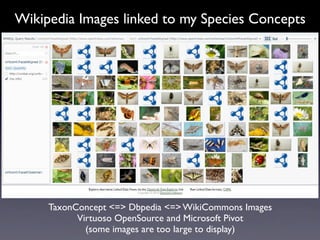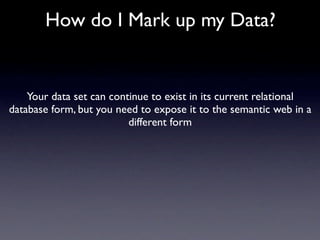Biodiversity Informatics on the Semantic Web
- 1. Biodiversity Informatics on the Semantic Web Pete DeVries TaxonConcept.org http://www.taxonconcept.org/ Department of Entomology University of Wisconsin - Madison
- 2. What is the Semantic Web and how does it Work? Lets Look at the Traditional Way Taxon Table Location Table This data structure is really only interpretable within the context of this specific database
- 3. Data Islands The result are database islands that contain a lot of redundant data which is independently curated. Each effort benefits little from the other efforts.
- 4. Data Sets often Overlap Text What they don’t have is a common set of field names or ID’s
- 5. Each Data set has is own “Vocabulary” Different Fields Different Names for the Same Fields Same Names for Different Fields Different ways of Interpreting those Fields These nuances in meaning are often only understood by the designers of each individual data set. Consider how differently people interpret the meaning of different fields in the various email discussions.
- 6. Where the Semantic Web Helps Tim Berners-Lee’s 4 Rules 1. Use URIs* as names for things 2. Use HTTP URIs so that people can look up those names. 3. When someone looks up a URI, provide useful information. 4. Include links to other URIs. so that they can discover more things. *URI = Uniform Resource Identifier http://www.w3.org/DesignIssues/LinkedData.html
- 7. Use URIs as Names for Things? Instead of “Door County” use http://sws.geonames.org/5250768/
- 8. For Humans this URI Dereferences To
- 9. For Machines this Dereferences To
- 10. Why Would Anyone Think this Made Sense? Now, each of these different databases are using an ID with a shared meaning. A meaning that can be determined by dereferencing the URI. All the data sets that use this vocabulary are now connectable. All the data sets that are linked to this URI are now also linked to each other.
- 11. As More Data Sets Adopt these Principles The individual datasets are no longer islands, but are one interconnected knowledge base
- 12. Other Benefits Reduced duplication of effort and a better separation of concerns It would be more efficient for me to simply link to a bibliographic reference URI on a site that specializes in that then to create my own bibliographic database. Similarly, it would be more efficient for the bibliographic database to link to a URI in a nomenclatural database than curates that aspect separately.
- 13. What is Linked Open Data? Linked Open Data (LOD) and the LOD Cloud are linked open accessible data sets A diagram of the subset of Linked Open Data that is described at http://ckan.net/
- 14. Wikipedia Images linked to my Species Concepts TaxonConcept <=> Dbpedia <=> WikiCommons Images Virtuoso OpenSource and Microsoft Pivot (some images are too large to display)
- 15. How do I Mark up my Data? Your data set can continue to exist in its current relational database form, but you need to expose it to the semantic web in a different form
- 16. Knowledge as Triples Statements are represented in a triple structure Subject ➜ Predicate ➜ Object • An English text version of a triple might look like • Ochlerotatus triseriatus expected in La Crosse County, WI
- 17. Machine Processable Version Ochlerotatus triseriatus is expected in La Crosse County, WI Now represented as the following triple* http://lod.taxonconcept.org/ses/iuCXz#Species http://lod.taxonconcept.org/ontology/txn.owl#isExpectedIn http://sws.geonames.org/5258961/ *Not Meant for Human Consumption
- 18. Expressing RDF RDF = Resource Description Framework Ways to Express RDF (Serialization Formats) RDF/XML http://www.w3.org/TR/REC-rdf-syntax/ Notation 3 (N3) http://www.w3.org/DesignIssues/Notation3.html Subsets of N3 Turtle (Terse RDF Triple Language) N-Triples
- 19. The Same Triple in Different Formats RDF/XML (.rdf) N3 (.n3) Turtle (.ttl) You might find one of these forms easier to create. There are various tools that will allow you to convert between one form and another. If you need RDF/XML, but can create N3; author in N3 then convert those files to RDF/XML.
- 20. How do I tell the Semantic Web about my Data? PingtheSemanticWeb http://pingthesemanticweb.com/ Semantic Sitemaps http://sw.deri.org/2007/07/sitemapextension/
- 21. PingtheSemanticWeb.com Enter the URL for your RDF documents
- 22. Semantic SiteMaps http://site.example.com/sitemap.xml http://site.example.com/sitemap.xml.gz Refer to the sitemap.xml file in your sites robots.txt file
- 23. How can I Find other Potentially Useful Data Sets? CKAN Comprehensive Knowledge Archive Network http://ckan.net/
- 24. Ask the LOD Cloud Enter in term or name like “Quercus alba”, to see what entities contain that term or name
- 25. LOD Cloud Query Result
- 26. How can I set up my own Knowledge Base? Virtuoso Open-Source Edition http://virtuoso.openlinksw.com/
- 27. How can I Query a Knowledge Base? SPARQL http://en.wikipedia.org/wiki/SPARQL http://www.w3.org/TR/rdf-sparql-query/ Query using the Web Interface Query using your own script or web application Example “Describe those occurrences of the species concept Boloria selene”
- 28. iSPARQL Query Example Web Interface
- 30. What does the Future old for the Semantic Web and Linked Open Data Improvements in the quantity and quality of LOD data sets. Improved Alignment of Vocabularies Improvements in SPARQL and Quadstores Human and Machine Interpretable Views Merged in RDFa Better Visualization and Analysis Tools
- 31. One More Thing! Now that many people have smartphones that can scan a barcode and load a specific web page, consider using URI’s to your web accessible database for things like collection drawers, specimen and species pages. QR Codes are one form of 2D barcode that seem to work well. http://en.wikipedia.org/wiki/QR_Code QuckMark seems to make an inexpensive reader for many smart phones. http://www.quickmark.com.tw =>
- 32. Other Resources Linked Open Data http://linkeddata.org/ W3C.org http://esw.w3.org/Main_Page public-lod email list http://lists.w3.org/Archives/Public/public-lod/ TaxonConcept.org http://www.taxonconcept.org/ Acknowledgments Kingsley Idehen http://www.openlinksw.com/blog/~kidehen/ David “Paddy” Patterson eol.org Dmitry Mozzherin eol.org
Editor's Notes
- #2: Today I am going to give you a brief overview of the semantic web and how it can be useful to biodiversity informatics.\n
- #3: Here is a traditional table in a spreadsheet. It is a list of the various species and includes ID field that is used to connect it to another table for locations.\nIn this we have a representation for taxa and a representation for location that are often specific to this and only this database.\nOther similar databases that might be useful will have different names for the fields, and different names within the fields for what is often the same entity. \nWhat you have is a data island that knows nothing else about potentially related data and shares nothing about itself to other data sets.\n
- #4: The result of this structure are large islands of data which are difficult to integrate. \nEach of these gains little value from other data sets and are of little value to other datasets.\n
- #5: \n
- #6: \n
- #7: 1.Use URIs as names for things\nUse HTTP URIs so that people can look up those names.\nWhen someone looks up a URI, provide useful information, using the standards (RDF*, SPARQL)\nInclude links to other URIs. so that they can discover more things.\n\n
- #8: \n
- #9: \n
- #10: \n
- #11: \n
- #12: \n
- #13: \n
- #14: Linked Data is data that is linked together following the principles laid out by Tim Berners-Lee.\nLinked Open Data is Linked Data that is open and accessible.\nThere are ways to query this knowledge base, but you can also create your own subset for your own knowledge base.\n
- #15: Since all these data sets are connected you can do some interesting things.\nHere is something I just tried this Wednesday.\nMy data set is linked to Wikipedia through Dbpedia I can easily pull in all the images for my species that are in Wikipedia.\nThe RDF icons are for images that are too large to be displayed.\n
- #16: Your data set can continue to exist in its current relational database form, but you need to expose it to the semantic web in a different form\n
- #17: The semantic web represents statements as triples.\nTriples consist of a subject predicate and object.\nAn english language version of a triple might look something like this. \n&#x201C;Ochlerotatus triseriatus occurrence in La Crosse County, WI\n
- #18: I can now use these unique identifiers to make machine processable statements about these entities.\nThe statement &#x201C;Ochlerotatus triseriatus is expected in La Crosse County, WI&#x201D;\nCan now be represented as the following triple\n&#xA0;<http://lod.taxonconcept.org/ses/iuCXz#Species>\n&#xA0;<http://lod.taxonconcept.org/ontology/txn.owl#isExpectedIn>\n&#xA0;<http://sws.geonames.org/5258961/> .\n&#xA0;It is important to recognize that these statements are part of the database, but they are not there for humans to process, they are there so that it is clear to this system and others what we actually mean.\n
- #19: \n
- #20: Here are the different ways of representing that original triple.\n
- #21: \n
- #22: \n
- #23: \n
- #24: \n
- #25: \n
- #26: \n
- #27: \n
- #28: Triple or Quadstores have their own SQL-like query language called SPARQL\n
- #29: \n
- #30: \n
- #31: Improvements in the quantity and quality of LOD data sets.\nImproved Alignment of Vocabularies\nImprovements in SPARQL and Quadstores\nHuman and Machine Interpretable Views Merged in RDFa\nBetter Visualization and Analysis Tools\n
- #32: \n
- #33: \n
































